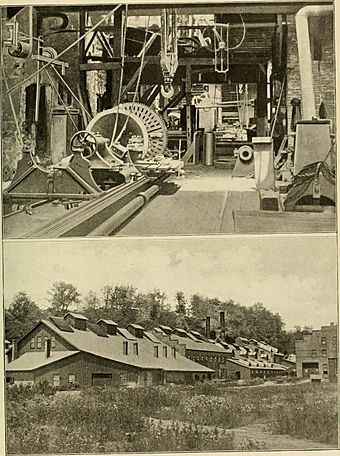West Point Foundry facts for kids
Quick facts for kids |
|
|
West Point Foundry
|
|

Scenes of the West Point Foundry in the 1890s
|
|
| Location | 68 Kemble Avenue, Cold Spring, NY 10516 |
|---|---|
| Nearest city | Beacon |
| Area | 93 acres (38 ha) |
| NRHP reference No. | 73001250 |
| Added to NRHP | April 11, 1973 |
The West Point Foundry was a very important factory in Cold Spring, New York. It was a big place where people worked with iron and made machines. The factory was open from 1818 until about 1911.
It became famous for making powerful cannons called Parrott rifles. These cannons and other weapons were used during the American Civil War. But the factory also made many iron products for everyday use. After the Civil War, people started using more steel instead of cast iron. This caused the factory to slowly lose money and close down in the early 1900s.
Contents
History of the West Point Foundry
Starting the Foundry and Early Products
The idea for the West Point Foundry came from President James Madison. After the War of 1812, he wanted factories in America to make their own cannons. Cold Spring was a perfect place for this factory. There was lots of wood to make charcoal, which was needed for iron. Many iron mines were nearby. Also, Margaret's Brook provided water power for the machines.
The factory was safe because the West Point military school was just across the Hudson River. The river also made it easy to ship the finished products.
The West Point Foundry Association was started by Gouverneur Kemble in 1817. His family were merchants from New York City. They tested their cannons by firing them across the Hudson River at Storm King Mountain. Sometimes, old cannon shells were found there years later. During cleanup work in the 1990s, they even found the platform used for testing the cannons.
Besides cannons, the foundry made other iron items for people to use. They made pipes for the New York City water system. They also built sugar mills that were sent to the West Indies. The foundry even built some of the very first trains (locomotives). These included the Best Friend of Charleston, which was the first train used for business. Other trains they built were the West Point, the DeWitt Clinton, Phoenix, and Experiment.
The Parrott Years and the Civil War
In 1835, Captain Robert Parker Parrott came to the foundry. He was an expert from the United States Military Academy at West Point. He was there to check the weapons for the U.S. Army. The next year, he left the Army and became the superintendent, or manager, of the foundry. This happened on October 31, 1836.
Under his leadership, the factory did very well. He experimented a lot with cannons and cannonballs. In 1860, he invented his famous Parrott rifle cannon. In 1843, the foundry also built the USS Spencer. This was a special ship for collecting taxes, and it was the first iron ship ever built in the U.S.A.
The foundry was busiest during the American Civil War. This was because the military ordered so many weapons. At that time, about 1,400 people worked there. They made 2,000 cannons and three million cannon shells. Robert Parrott also invented a special burning shell. This shell was used with a large 8-inch Parrott rifle cannon called the "Swamp Angel" to attack Charleston. The factory was so important that President Abraham Lincoln himself visited it in June 1862.
The West Point Foundry was so famous that the writer Jules Verne mentioned it. In his book From the Earth to the Moon, he said the foundry built a giant cannon to launch a spaceship!
Decline and End of Operations
In 1867, Robert Parrott stopped being the superintendent. He still worked on cannon designs until he died in 1877. After he left, the factory's business slowed down. Newer ways of making iron and steel were being developed, and the foundry couldn't keep up. Around 1870, they stopped using charcoal and started buying coal from Pennsylvania.
However, these changes were not enough. The factory faced financial trouble in 1884 and went bankrupt in 1889. In 1897, it was sold to the Cornell brothers, who made sugar mills. The West Point Foundry finally closed down completely in 1911.
Exploring the Site Today
|
West Point Foundry Archeological Site
|
|
| Lua error in Module:Location_map at line 420: attempt to index field 'wikibase' (a nil value). | |
| Location | Address Restricted, Cold Spring, New York |
|---|---|
| Area | 100 acres (40 ha) |
| Built | 1817 |
| NRHP reference No. | 10000059, 100006260 |
| Significant dates | |
| Added to NRHP | February 25, 2010 |
| Designated NHLD | January 13, 2021 |

Today, most of the buildings at the West Point Foundry are in ruins. Only the main office building is still standing. About 87 acres (35 hectares) around the site are now a protected area. This land is owned by a group called Scenic Hudson. You can visit the site by taking a short walk from the nearby Cold Spring train station.
From 2002 to 2008, a big study of the site was done by Michigan Tech, with money from Scenic Hudson. This study helped us learn a lot about the old factory. The West Point Foundry Archeological Site was added to the National Register of Historic Places in 2010. In 2021, it was named a National Historic Landmark, which means it's a very important historical place in the United States.



